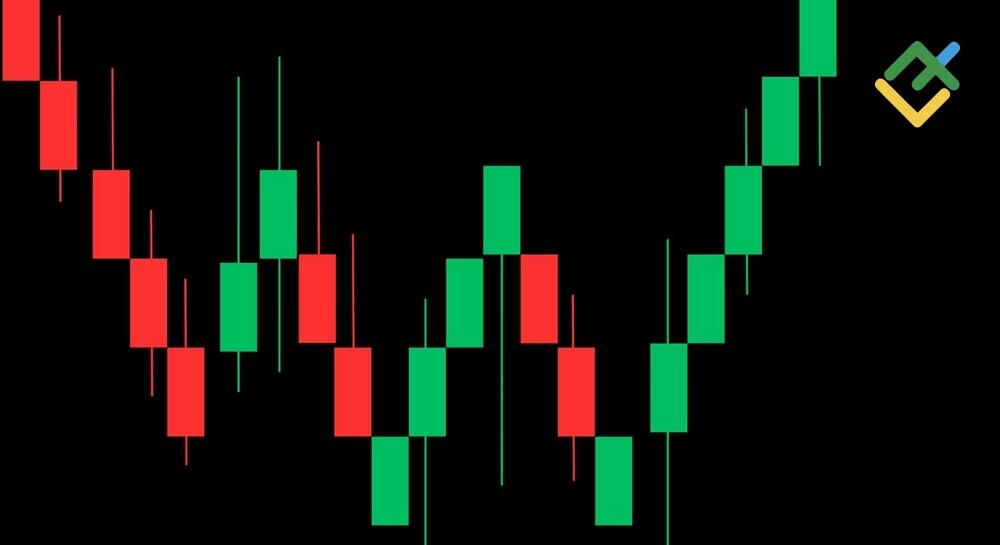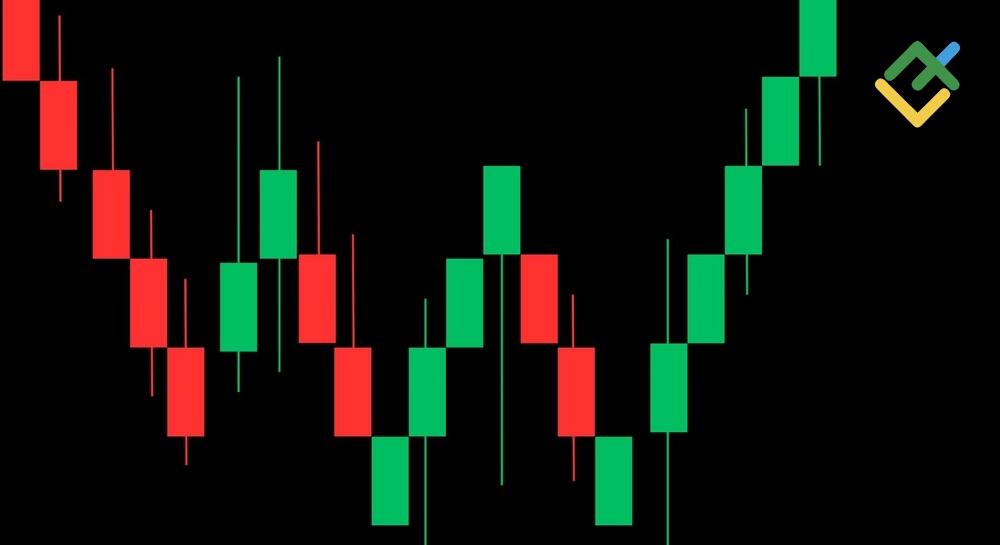Double Candlestick Patterns: Meaning, Types & Trading Strategies

In technical analysis, Japanese candlestick patterns are among the key tools for predicting future asset prices.
Among the many patterns, two-candlestick formations are particularly important. These dual candlestick patterns arise from the interaction of supply and demand and reflect the sentiment of market participants.
This article provides a detailed overview of what double candlestick patterns are, their types, and the trading strategies they can be used for.
The article covers the following subjects:
Major Takeaways
- Double candlestick patterns are technical analysis formations consisting of two consecutive candlesticks that signal a possible trend reversal or continuation.
- To recognize a two candle pattern, find two candlesticks that form a clear signal: a reversal pattern after a prolonged movement or confirmation of the current trend.
- The most popular two candlestick reversal patterns are: Bullish Engulfing, Bearish Engulfing, Piercing, and Dark Cloud Cover.
- The trading strategy involves entering a position after the pattern is validated, with a stop-loss placed below the low/high of the second candlestick to limit potential losses.
- Strategies include validating the signal with other technical indicators, identifying optimal entry and exit points, and managing risk based on volatility.
- Pros: easy to identify signals. Cons: false signals are possible; confirmation with other technical tools is required.
- Multiple candlestick patterns occur on different time frames, but the most reliable ones form on higher time frames. The patterns are applicable to currency, stock, and cryptocurrency markets.
Understanding Double Candlestick Patterns
Double candlestick patterns give market participants signals about possible trend shifts or confirm the current trend. These patterns consist of two candles on a price chart.
The formation of double stick patterns begins with an analysis of the first candlestick, which indicates the initial market sentiment. The second candlestick plays a decisive role, confirming market sentiment. Analysis of the ratio of the bodies and shadows of both candlesticks allows you to determine the strength and direction of future price movements.
For example, if the first candlestick is large and rising, and the second is small and falling, this may indicate a weakening of the upward trend. Conversely, if the first candlestick is small and bearish, and the second is large and bullish, an upward trend reversal is possible.
Double Candlestick Pattern Classification and Reliability
There are different types of candlestick patterns, among which single candlestick patterns and double candlestick patterns stand out. Understanding the differences between them is critical to successful trading.
- Single candlestick patterns represent one candlestick, signaling a possible change or continuation of a trend. Examples of such patterns include Hammer, Hanging Man, Doji, and Shooting Star candlesticks.
- Double candlestick patterns are formed by two consecutive candlesticks. They give stronger signals because there is confirmation from the second candlestick. These patterns include the Bullish Engulfing Pattern, Bearish Engulfing Pattern, Piercing, and Dark Cloud Cover.
Most Common Types of Double Candlestick Patterns
Double candlestick patterns are popular because they are easy to interpret and their signals are reliable. Unlike single candlesticks, dual candlestick patterns take into account price movement over two consecutive periods. In this section, we will take a detailed look at the most popular double candlestick patterns.
1. Tweezer Tops
A Tweezer Top pattern is a bearish candlestick reversal pattern that appears at the peak of an uptrend and indicates a likely decline in prices. The first candlestick is usually bullish, i.e., it closes higher than it opened, confirming the continuing bullish trend. The second candlestick is bearish, pointing to an impending reversal.
The main feature of the Tweezers Top is that both candlesticks have approximately the same highs, suggesting that buyers were unable to push the quotes higher, and sellers took the initiative at these highs. On a price chart, it resembles tweezers grabbing the top of the trend.
This pattern should be traded with caution. After it forms, you need to wait for confirmation of a bearish trend reversal. This could be a breakout of the support level or the appearance of other bearish signals that indicate the market is overbought.
Short positions can be opened once the price breaks through the support level. A stop-loss order can be placed above the formation’s highest point. To determine a take-profit level, you can use previous lows or Fibonacci levels as a reference.
2. Tweezer Bottoms
A Tweezer Bottom is a bullish reversal pattern that indicates a possible end to a bearish trend and a potential reversal. The first candlestick is usually bearish, while the second candlestick is bullish.
Both candles should have long bodies and short shadows, although this is not strictly necessary. The key is that the lows of both candlesticks should coincide or be very close to each other to form a horizontal line on the chart. This pattern tells traders that the price has encountered strong support at a certain level and sellers have been unable to drag the price lower.
A trading strategy suggests opening long positions after confirmation of a Tweezer pattern. For example, when the following candlestick closes above the high of the pattern's second candlestick.
A stop-loss is usually placed slightly below the low of both candlesticks. The profit target can be determined based on historical resistance levels or using various technical indicators, such as Fibonacci retracement levels.
3. Bearish Engulfing Pattern
A Bearish Engulfing pattern is a double candlestick reversal pattern. It consists of a small bullish candle and a large bearish candle. The body of the downward candlestick should completely overlap the body of the preceding upward candlestick, regardless of the length of the shadows.
This candlestick pattern indicates that the upward momentum is losing steam. Bulls are not strong enough to continue the rally, and bears are taking control and pushing the price below the high of the first candlestick. The large bearish candlestick demonstrates strong selling pressure, which often leads to further declines.
A trading strategy using the bearish engulfing pattern requires confirmation of an uptrend. Then, when the pattern is found, wait for the bearish candlestick to close. The signal is confirmed when the next candlestick opens below the close of the bearish candlestick.
You can open a sell trade once the price pierces the swing low formed by the pattern. A stop-loss is usually set above the bearish candlestick. When setting the take-profit, you should rely on support and resistance levels and risk management rules, including the risk-to-reward ratio.
4. Bullish Engulfing Pattern
A Bullish Engulfing pattern gives a powerful signal of a bullish reversal. It appears in downtrends and predicts potential growth. It is formed by two candlesticks: a short bear candle, which is completely engulfed by a subsequent long bull candle.
The pattern indicates a shift from bearish sentiment to bullish. The decline gradually weakens, and bulls begin to dominate the market, driving prices higher.
To trade the bullish engulfing pattern successfully, you need to confirm it first. The best way to do this is to wait for the next candlestick to close after the pattern forms. An upward trend is confirmed when the bullish candlestick closes above the high of the pattern’s second candlestick.
Set a stop-loss below the low of the second candlestick and a take-profit at the nearest resistance. The pattern is especially effective when trading on daily or weekly charts, where signals are more reliable and market noise is filtered out.
5. Kicking Pattern
In candlestick analysis, a Kicker pattern is a strong harbinger of a major shift in market sentiment. This pattern consists of two candlesticks moving in opposite directions, separated by a significant gap.
A bullish Kicker pattern appears when a long bull candlestick appears after a downtrend, opening significantly higher than the previous bear candlestick, reflecting strong buying pressure and a potential upward trend reversal.
A bearish Kicker pattern occurs when, after a prolonged upward movement, a long bear candlestick appears and is significantly lower than the previous bull candlestick, pointing to an emerging downtrend.
You should trade the Kicker pattern with caution. After identifying the pattern, wait for a subsequent candlestick to form in the direction of the new trend, which will confirm the reversal.
Place a stop-loss slightly below the low of the bullish candlestick or slightly above the high of the bearish candlestick. The profit target can be at the previous high or low, depending on the trend.
6. Bullish Harami
A Bullish Harami is a bullish reversal pattern. The pattern consists of two candlesticks: the first one is a long bearish candle that completely engulfs the following bullish candle.
The first candlestick reflects strong selling pressure, while the second candlestick reveals a weakening of this pressure and a potential increase in buying activity.
Trading the Bullish Harami pattern requires confirmation of the reversal. It is not enough to simply spot the pattern; you need to wait for a bullish candlestick to form after the pattern. Optimally, the price should close above the high of the first bearish candlestick.
As a rule, a stop-loss is placed below the low of the first candlestick to limit potential losses if the reversal does not occur. The profit target may be the next resistance level. The bullish Harami pattern signal becomes stronger if the pattern forms at key support levels or is confirmed by other technical indicators.
7. Piercing Line
A Piercing Line is a bullish reversal pattern that forms at the bottom of a downtrend.
The pattern consists of two consecutive candlesticks:
- The first one is a long bearish candlestick, signaling a continuation of the downtrend.
- The second long bullish candlestick opens with a down gap and closes above the middle of the first candlestick.
The Piercing Line pattern marks a possible change in market sentiment. The down gap at the opening of the bullish candlestick shows that buyers are initially weak, but then they start a strong rally. As a result, the candlestick closes above the middle of the previous candlestick, signaling a potential trend reversal to an upward trend.
Trading using the piercing pattern requires a trend reversal to be confirmed. Traders usually wait for a confirming bullish candlestick appearing on the next trading day, which closes even higher.
The long trade is opened when the price breaks through the high of the bullish candlestick. A stop-loss is set below the low of the bullish candlestick. It is necessary to consider the broader market context and use additional indicators to confirm trading signals. A take-profit is calculated based on historical resistance levels.
8. Dark Cloud Cover
A Dark Cloud Cover pattern is a bearish reversal pattern that often precedes an uptrend’s end.
The pattern consists of two candlesticks:
- The first large bullish candlestick continues the upward movement.
- The second bearish candlestick opens above the previous candlestick’s high but closes significantly lower, at least halfway down the first candlestick’s body.
This pattern displays a shift in market sentiment. The opening of the second candlestick with an upward gap creates the illusion of a continuation of the bullish trend, but the subsequent decline and closing within the body of the previous candle indicate the strength of sellers.
When trading with the Dark Cloud pattern, you should look for extra bearish signals, like a trend line breakout or other bearish patterns.
The best entry point into short trades is just below the closing price of the second candlestick, and a stop-loss should be placed just above the highest price.
9. Bearish Harami
A Bearish Harami is a reversal candlestick pattern that confirms the end of an uptrend and generates a bearish reversal signal.
It consists of two candlesticks: a large bullish candlestick that completely covers the second bearish candlestick. A pronounced bullish candlestick indicates a continuation of the uptrend, while a small bearish candlestick indicates weakening bullish momentum and a possible change in market sentiment.
Trading with the bearish Harami requires confirmation, such as a breakout of the support level or another bearish candlestick following the pattern.
10. Matching Low
The Matching Low candlestick pattern signals a bullish reversal signal. As a rule, the formation emerges at the end of a bearish trend. The pattern consists of two consecutive bearish candlesticks that close at almost the same level and form a horizontal line near the price lows.
The first candlestick is bearish, confirming the downtrend. The key point is the second candlestick, which is also bearish but closes at almost the same level.
This setup indicates that selling pressure is weakening and buyers are becoming more active, preventing the price from falling below a certain level.
Trading with the Matching Low pattern requires confirmation of the signal, such as the formation of a bullish candlestick after the pattern.
A long position can be opened after the confirming bullish candlestick is complete. A stop-loss order is placed just below the low of the Matching Low, while a take-profit order can be set at the nearest resistance level.
Implementation in Technical Analysis and Trading
Let’s explore how to use double candlestick patterns:
- Double candlestick patterns are reliable indicators of a possible trend reversal. The analysis begins with identifying a clear trend, either upward or downward. After that, you need to closely monitor the formation of key patterns.
- The signal is confirmed by additional technical tools, such as trading volume, support/resistance levels, and indicators such as the RSI or MACD. An increase in volume during the formation of a bullish pattern or the crossing of the resistance line after its appearance is a reliable signal of a trend reversal.
- Finding entry and exit points. The best entry point occurs after a reversal signal is confirmed. For example, after a candlestick closes, confirming a Bullish Engulfing pattern. Place a stop-loss below the low of the bullish pattern or above the high of the bearish pattern.
- Risk management. It is necessary to carefully calculate the size of the position to avoid losing your capital. The risk/reward ratio should ensure that the potential profit exceeds the potential loss. Regular adjustment of stop-loss orders can significantly reduce risks.
- When trading with patterns, consider fundamental factors. A pattern formed against a backdrop of positive news and high demand is strong, and trades can be opened. Comprehensive analysis allows you to make more informed and balanced trading decisions.
Complementary Technical Indicators
Double candlestick patterns give more reliable signals when combined with technical indicators.
- MACD tracks the correlations between two moving averages, allowing you to identify changes in momentum and trend direction.
- The RSI assesses the speed and magnitude of price changes to determine whether an asset is overbought or oversold.
- The stochastic oscillator compares the value of an asset with the price range over a certain period of time, making it easier to identify overbought/oversold areas.
- The OBV indicator measures the ratio of buyers to sellers based on trading volume.
- The MFI uses price and volume data to gauge trend strength and reversals.
- VWAP calculates the volume-weighted average price of an asset, which is a benchmark for assessing the current price relative to the average.
- Bollinger Bands frame price movements within dynamic boundaries, reflecting market volatility and areas of support and resistance.
- Fibonacci retracement levels are used to identify likely support or resistance levels, i.e., potential reversal points.
Advantages and Disadvantages of Double Candlestick Patterns
Like any trading technique, double candlesticks have their advantages and disadvantages.
Advantages of Dual Candlestick Patterns
- They can be used on any time frames and markets.
- The patterns are easy to find on a candlestick chart, even for novice traders.
- Signals are generated relatively quickly compared to other technical indicators, allowing you to react promptly to market changes.
- Signals can be confirmed by other technical analysis tools to increase their reliability.
- There are many double candlestick patterns, each of which reflects the market situation.
Disadvantages of Dual Candlestick Patterns
- The formations may generate false signals, especially during periods of high volatility or flat markets.
- Signals require confirmation with other technical indicators or patterns, which can slow down your decision-making.
- The effectiveness of the patterns depends on the overall market context, including the trend, support, and resistance levels.
- The signal is only generated after the second candlestick closes, so you might miss the opportunity to open a profitable trade.
Conclusion
Two-candlestick patterns are indeed useful tools. You will be able to make more informed trading decisions if you gain a deeper understanding of these formations and learn to interpret their signals.
However, remember that no candlestick pattern offers a completely reliable signal. Successful trading requires a comprehensive approach that encompasses trading volume, support and resistance levels, and risk management.
Try your hand at trading with double candlestick patterns on a risk-free LiteFinance demo account.
Get access to a demo account on an easy-to-use Forex platform without registration
Go to Demo Account
Double Candlestick Patterns FAQs
The content of this article reflects the author’s opinion and does not necessarily reflect the official position of LiteFinance broker. The material published on this page is provided for informational purposes only and should not be considered as the provision of investment advice for the purposes of Directive 2014/65/EU.
According to copyright law, this article is considered intellectual property, which includes a prohibition on copying and distributing it without consent.






